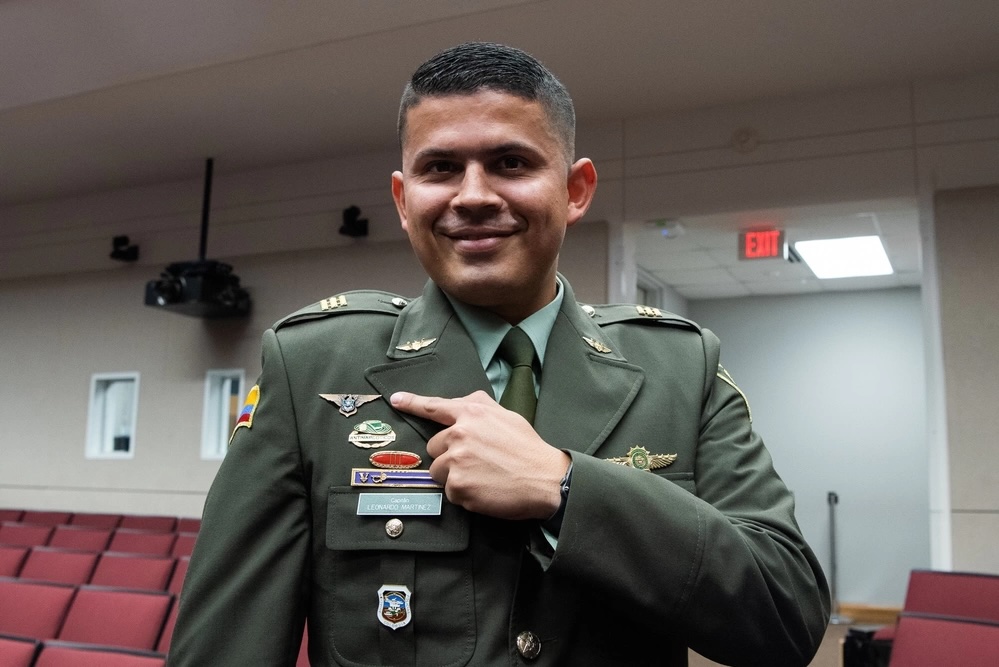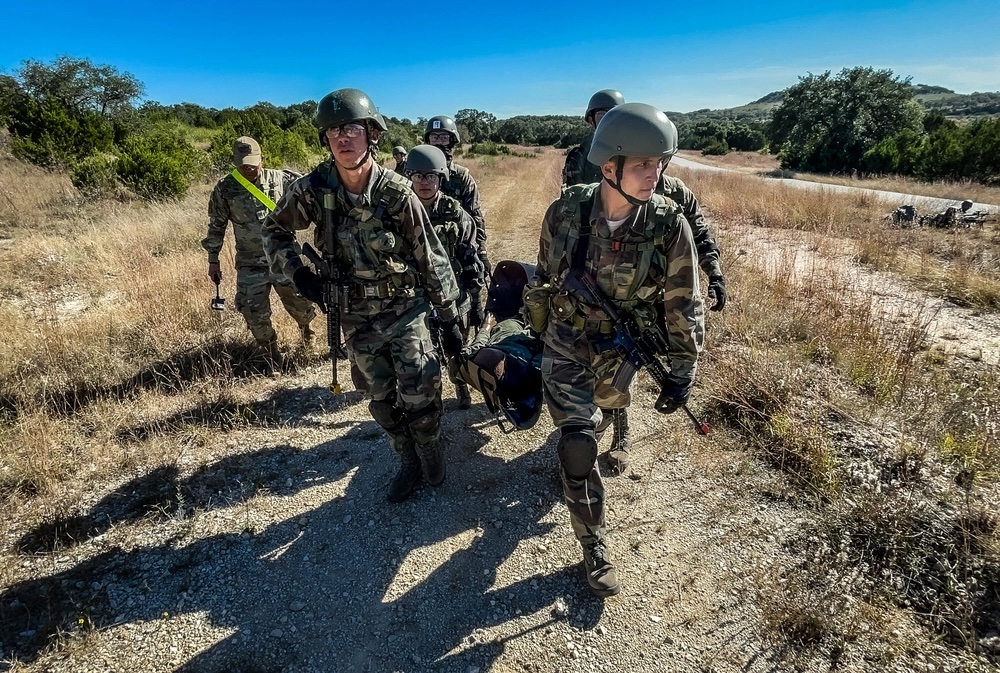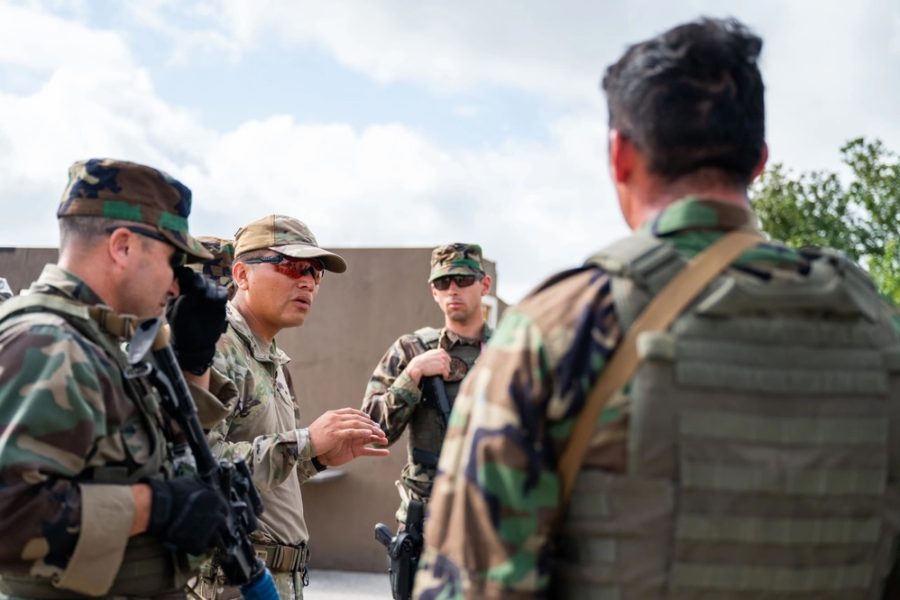Joint Base San Antonio-Lackland may be a U.S. Air Force base in south-central Texas, but at the corner of Selfridge Boulevard and Carswell Avenue is an international Spanish-speaking campus hosting students and instructors from across the Western Hemisphere.
The Inter-American Air Forces Academy offers more than 30 courses in aircraft maintenance, cyber and intelligence operations, security forces high-risk response, instrument flying, professional military education, and much more. The goal is to build security cooperation among U.S. partners in Central and South America, especially as the United States’ main rival, China, looks to influence the region.
“We’re a tool of security cooperation in the western hemisphere,” Lt. Col. Maxim Olivine, deputy commandant of IAAFA, told Air & Space Forces Magazine. “The intent for IAAFA’s existence is really to bridge the gap between our Spanish-speaking South American partners and the United States.”
IAAFA aims to help students become more proficient at their craft or prepare them for new levels of leadership and responsibility. Some Central or South American partners don’t have that type of training back home, Olivine said, but most students come to Lackland because of the U.S. Air Force’s reputation as the best in the world. The pair of wings IAAFA students receive upon graduation has a cachet similar to that of an Air Force Weapons School patch or a Ranger Tab.
“It’s very prestigious for a lot of the folks who come to us,” he said. “When they go back home, they’re very proud of that.”

Expert Instruction
The students at IAAFA include troops and civilians from a wide range of backgrounds and experience levels. From brand-new national policemen to seasoned jungle commandos, they all can pick something up at IAAFA.
“They might think they can’t learn anything, but they always do,” said Master Sgt. Johann Gonzalez, flight chief for international force protection at IAAFA and a prior instructor at the U.S. Air Force’s Security Forces Weapons and Tactics Instructors Course.
Gonzalez remembered a Colombian sniper who shot perfectly on the range but was a novice when it came to shooting, moving, and communicating during practice field operations.
“He went from shooting 100 percent to maybe about 25 percent, because now we were inducing stress,” the sergeant said. “He’s just like ‘what did you guys do to me, I thought I was good.’”
But by the end of the course, the sniper was back to shooting 100 percent. Technology helps: the IAAFA security forces instructors have a virtual reality system where students practice hostage situations, gate assaults, and any other crisis they might encounter, all without having to buy a single bullet, hire a single role player, or clean up one spent brass.
“I’ve been doing this for 21 years and there’s nothing that compares to being in the field,” Gonzalez said. “However, you start using this technology the right way, you run students through 20, 30 scenarios, and you realize that you get better.”
Virtual reality is just the latest development in IAAFA’s 80 year-history. The academy started in 1943 with just 10 enlisted Peruvian troops and 1 officer taking aviation mechanics courses at a U.S. Army airfield in Panama. Over time, the school relocated and expanded its course catalog to the point where it now graduates about 800 students in a wide range of subjects every year.
Classes at IAAFA last between two and eight weeks, depending on the subject. About two dozen countries participate in the academy, including countries where Spanish is not the official language such as Brazil, Canada, Suriname, Jamaica, and Haiti. Students and instructors from those countries can participate as long as they are fluent in Spanish.
“The scope of the mission just kept growing because it was effective,” Olivine said. “It created that security cooperation, it built those foreign policy relations with other nations.”

It also helps to have high-quality instructors. On the security forces side, Gonzalez is a Weapons and Tactics Instructor Course instructor and a U.S. Army sniper school graduate. Another instructor, Tech. Sgt. Edwin Nieves, has degrees in education, while a third, Staff Sgt. Edgar Bravo, is a Combat Arms instructor.
Then there are the instructors from partner nations who come to teach at IAAFA: Gonzalez recalled one instructor from the Commando Jungla, Colombia’s anti-narcotic jungle warfare unit.
“He had everything: sniper certified, rappel master, land navigation, troop-leading, everything you would want from a special warfare operator,” Gonzalez said. “He taught us a lot, and we taught him a lot, too. He was like ‘man, you guys taught me some good stuff, I’m sending my guys down there.’”
Instructors work at IAAFA for three or four years, the first six months of which are spent being trained for the job. That’s a significant time commitment in the military, which often promotes leadership experience over teaching experience, but it’s worth it for instructors who feel teaching is their calling.
“These guys, they get done with their four years, everybody asks to extend … because they love what they do,” said Gonzalez.
“We take guys that can’t shoot, and then they shoot,” he added. “We teach combatives: we take guys who’ve never fought in their life, and then by the end they’re throwing people around like it’s MMA.”
Leadership Roles
One of the most important skills taught at IAAFA is empowering troops at all levels to think for themselves so they can respond to situations dynamically.
“I truly believe that what makes us great is not so much our technology and fancy weapons systems: it’s our troops, especially our enlisted troops,” Olivine said.
On the security forces side, Gonzalez likes to swap out leadership roles by putting the low-ranking grunt in charge of a stack of troops breaching a house, for example.
“We put them in leadership roles they might not have been in in their home countries,” he said.

Growing that kind of mindset takes time in militaries that don’t have it already, but IAAFA has graduated thousands of students over its 80-year history, and some graduates go on to take top-ranking positions in their home countries. Olivine thinks that kind of steady percolation eventually leads to cultural change.
“Change is hard. It takes time, it takes effort, it takes consistency,” he said. “Over time, you change enough mindsets and you become very effective.”
Students also take a class about understanding human rights, according to the course catalog. IAAFA relies on the U.S. State Department’s Leahy vetting process, where the human rights records of foreign military units or individuals are screened before receiving U.S. funding or training.
“Every country has its dark past, but we rely on that process to prevent that from happening again,” Olivine said. “The risk is always there, but it seems pretty small to me because of the Leahy vetting process.”
Two-Way Street
Learning at IAAFA goes both ways, as IAAFA students share their skills and experience in areas such as jungle warfare, which many U.S. Airmen are unfamiliar with.
“There’s a lot of that back and forth both in the tactical mindset and for professional military education,” Olivine said. “A South American country views the world very differently than the way the U.S. views the world.”
Olivine has been at IAAFA for only about eight months, but he’s already noticed the culture is particularly tight there, thanks in part to group sports events, asadas (a kind of barbecue), field trips around Texas, and more. For example, Gonzalez has both a U.S. flag and a Mexican flag hanging in his office, which he said Mexican students love to see.
“You are who you’re supposed to be, and I’m supposed to be a master sergeant in the United States Air Force,” he said. “But here, IAAFA allows me to be Johann Gonzalez, Master Sergeant, United States Air Force security cooperation.”
Ultimately the purpose of all that bonding and instruction boils down to security cooperation, which pays off when students from different countries who met at IAAFA help each other respond to real-world crises.
“What we’re trying to do, at the end of the day, is to make us one big team,” Olivine said.
